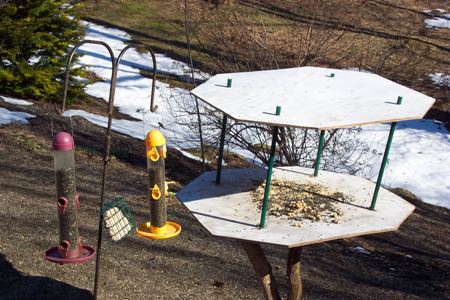Several days ago I made good on a promise to help a friend prune an apple tree. When he called the night before to pick a time I suggested three in the afternoon. Apparently he was thinking morning because he said that he would get started before I arrived.
On arrival I could have turned around and went home because his pruning job was already worth at least a B+ and more likely an A-.When he claimed that he did not know anything about pruning, I offered a few suggestions and put a few additional limbs on the ground and we were both happy.
My guess is that all most of you need is reassurance before you will grab the saw and shears.
At our location, the sun will only penetrate about four feet into a tree's canopy. Anything behind that four-foot line will be weaker and produce fruit of lower quality. That's a very good reason to keep fruit trees small.
Generally we are a bit timid. My rule of thumb for successful fruit is to thin branches until your shirt would be speckled with shade and sunlight if you lay under the tree after it had fully leafed out.
Another thought is to prune until you are happy and then remove half of what is left. I add that only because I am sure you won't do it, but I also hope you remember it when you pick up the saw and shears.
The biggest sin I see is pruning cuts that leave a stub that you could use as a clothes hanger. If you look at a limb you will notice that it is a bit fatter where it joins another branch. Often it looks like a ring. Cut as close to that ring as you can but not into it.
If you have apples or pears, get moving. The best fruit on these forms on branches that angle upward at about 45 degrees. Branches that are flat or hang down are less vigorous and will give lots of fruit but of lesser quality. Branches that are straight up just want to grow and provide unneeded shade.
For peaches, nectarines, plums and sweet cherries wait at least until you see a bit of bud swell, which should carry an April date. The best peaches and nectarines form on vertical shoots about the thickness of a pencil. Peaches and nectarines are quite vigorous, so getting them isn't too hard.
Sweet and sour cherries and plums behave nicely if you control height and thin a little. Sour cherries can be pruned now if you wish.
On grapes, there is a bud at each leaf from last year. Leave 20 or 30 buds and then ten additional buds for each pound of wood you remove. A well-pruned grapevine will look rather naked but don't take a scales to the garden with you. March is the best time.
Blueberries like five to seven stems from the ground for each bush. If you remove the oldest stem each year while keeping the best new stem, you will be fine. Little else is needed. Again, now is a good time to prune.
If I mention raspberries I am on thin ice. Black ones produce the best fruit on second year stems. Red ones can be handled the same or mowed to the ground after the spring harvest.
Grab the shears and go prune. Quick, cause you won't hear that from me too often.
